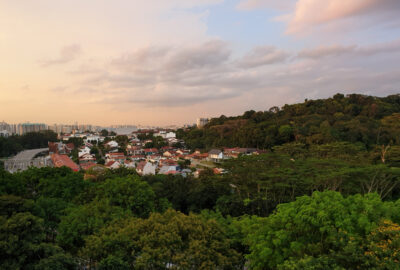A Singaporean president’s son comes into his own
Taking over the practice of his father, former President Ong Teng Cheong, was just the start of an extraordinary journey for designer Boon Tze Ong

Bounding up to the bustling Chinatown café where we’ve arranged to meet, grinning broadly and greeting the owners, Ong Tze Boon evinces the kind of verve you’d expect in a man half his age. He’s about as far removed from stereotypical images of middle-aged CEOs as you could imagine.
Sporting a salt-and-pepper goatee, turquoise T-shirt and light casual jacket, he epitomises a bohemian chic that reflects his exuberant yet intimate conversational manner, body language – he’s frequently tactile – and business ethos. His transatlantic tone stems from a decade in California and New York that he describes as having “changed [his] mind-set, perspective and reflectiveness”.
Though very much his own creation, it’s impossible to discuss Boon’s career without mentioning his late father, Ong Teng Cheong – and not only because it was he who set up Ong&Ong, the practice Boon now helms.
Not only was the elder Ong a leading architectural figure himself, he also happened to be the fifth president of Singapore, serving between 1993 and 1999.
Upon his father’s death in 2002, Boon, recently returned from the States, found himself between a rock and a hard place. As the shockwaves of the Asian financial crisis reverberated, work was drying up for upscale building companies. Boon’s strategy was to radically expand both the company’s remit and its international reach.
“I got creative and started thinking: If someone’s building, he’s got to build the interior, the landscape,” he recalls. “What if, instead of only doing architecture, I offer the client the interior as well? That was our foray into integrated disciplinary practice. Once we started, the clients liked it – particularly in surrounding countries. That was the precursor to our ‘360-integrated solution’, and on that platform we grew.”
Fifteen years later, Ong&Ong operates in 10 countries, and undertakes projects right across Asia, as well as Australia, America and Cyprus. “We’ve done every kind of project except two types: airports and prisons,” Boon says.
The firm is perhaps best known in its native Singapore for its involvement in countless high-end residential projects from the recently completed Spottiswoode Suites to executive condos including Blossom Residences, as well as embassies, schools and religious buildings. Overseas, Ong&Ong has, among other things, built up a reputation for its five-star resort properties like Layan Beach Resort on Phuket, Marriott Bintan in Indonesia and Alma Resort in Vietnam’s up-and-coming Cam Ranh Baya area.
DESIGN IS NOT ABOUT HOW IT LOOKS, BUT HOW IT WORKS. IF YOU KNOW HOW IT WORKS, YOU CAN GET ON WITH DESIGNING IT. IF YOU DON’T, YOU’RE JUST SHOOTING IN THE DARK
A key factor in the company’s success is its emphasis on human-centred design – re-imagining the building process such that end users, whether they are condo residents, shoppers or hotel guests, benefit most. “What we sell to clients is, ‘Let’s try and understand the end experience’, then work it backwards to determine what we must do,” explains Boon.
“You talk to the end user first,” he continues, emphasising the noun. “Most of the time, the clients don’t know what they want. So we hear the feedback, formulate an answer, then start crafting the design – not just the building but the lighting, the branding, the touchpoints. Design is not about how it looks, but how it works. If you know how it works, you can get on with designing it. If you don’t, you’re just shooting in the dark.”
An unorthodox MO perhaps, but one that’s indisputably paid dividends. Once almost exclusively tasked with residential projects, Ong&Ong has since been commissioned to design banks, malls, a mosque and, recently, two of the Malaysian stations that will form part of the imminent high-speed rail (HSR) link between Singapore and Kuala Lumpur.
The latter would have been of great interest to Boon’s father, one of the foremost proponents of the Lion City’s now-extensive MRT system. I put it to him that where Singapore – with its well-constructed pavements and abundant walking routes – once had too few stations, now it feels almost like it has too many. It’s a proposition he counters in typically mind-bending fashion.

“Transit work is based on an understanding that it cannot be a congregation of everything in one place, because when that happens the system around it won’t work,” Boon expounds. “So, you create a hierarchical segregation of the hip and not-so-hip place, suburbia. But if you exercise public transport right, you start to decentralise some of this. Like in Malaysia: Putrajaya, Cyberjaya. It creates a concentration in different ways, but within each of those pockets it can still be pedestrian-friendly. If you don’t recognise that you need mass transit, you’re in trouble in the long run. Meanwhile, don’t ignore, neglect or forget people.”
It’s clear that while his cultural and professional outlook is truly global, Boon remains deeply proud of his home nation’s breakneck-speed development. “In Singapore, they’ve come to terms with [the idea that] separating the commercial and residential completely is not the way. With transit development, where you mix commercial and residential, you get a third level, which is community, zoning and use – activating the community to work and play. Not to ‘live here, work there and play there’. And I think it’s lovely; you don’t have all these abandoned ghost towns.”
Seemingly a humanist as much as an architect, the interaction of people with buildings is his life’s fascination and life’s work. As he waxes lyrical about his experiences across Asia, he delves deep into considerations most travellers would barely contemplate.
“Anthropological cultures are different,” he explains. “In India for example, the maid’s room is a big thing, because there are so many domestic helpers. The yard is crucial; whereas in Singapore’s modern apartments, there’s not much yard left. Aside from all the feng shui and vastu [Indian architectural science], cultural inputs are different, sensitivities are different, conducts are different. In Singapore, you would not be surprised to see the kitchen as the centrepiece. That opens an opportunity to activate the backyard; the yard can become a garden, because the dining room becomes an extension of that garden.”

While masterminding an ever-expanding business should be more than enough to occupy any architect, Boon’s unquenchable curiosity has led him to unusual quarters of late. In 2015, he learnt of his compatriot David Lim’s pioneering mountain climbs in 2005, immortalised in the book Against Giants, which details the ascent of a Central Asian summit Lim named after Boon’s father. Himself a veteran of such mighty peaks as Kilimanjaro, Rinjani and Kota Kinabalu, Boon decided to investigate further.
“I Googled ‘Ong Teng Cheong peak’, and found nothing,” recalls Boon. “I realised that all David had done was to climb the mountain, chose to call it that, and published that book. I keyed in the co-ordinates on Google, but they led to the valley. So, in 2016 I climbed the one he pointed out, documented it with modern technology – and with all the video evidence, I approached the government of Kazakhstan and said, ‘I’m just remaking the journey of another man who did this years ago.’
“I filed it with the Kazakh government, and they said, ‘Who is Ong Teng Cheong?! Ah, the first elected president! Okay, can consider!’ On 28 June 2017 they officially adopted the name.”
While clearly not short of extracurricular interests, it seems unlikely that Boon will follow in his father’s political footsteps. “I think there may not be enough of a place for me there,” he ponders, seemingly amused by the prospect. “Would I rule out contributing to the community? Of course not. But I think it’s well under control.”
This article originally appeared in Issue No. 146 of PropertyGuru Property Report Magazine
Recommended
Meet the expert helping overseas investors crack Australia’s property market
Ivan Lam of property advisors Charter Keck Cramer helps clients navigate Australia’s complex real estate dynamics
6 spots to check out in Singapore’s Bukit list neighbourhood
The sought-after Singapore neighbourhood offers lifestyle amenities, green space, and new residential projects
Thailand’s real estate sector watches closely as the Shinawatras return to power
Time will tell if the return to power in Thailand of the Shinawatras will lift the country’s ailing real estate sector
China’s homebuying surge: Can new stimulus measures keep the market rally alive?
Stimulus measures have sparked a surge in homebuying activity around China, but many are sceptical the shift will endure







